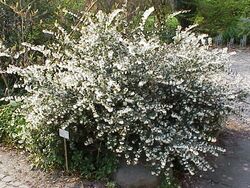Biology:Osmanthus delavayi
| Osmanthus delavayi | |
|---|---|

| |
| Scientific classification | |
| Kingdom: | Plantae |
| Clade: | Tracheophytes |
| Clade: | Angiosperms |
| Clade: | Eudicots |
| Clade: | Asterids |
| Order: | Lamiales |
| Family: | Oleaceae |
| Genus: | Osmanthus |
| Species: | O. delavayi
|
| Binomial name | |
| Osmanthus delavayi | |
| Synonyms[1] | |
| |
Osmanthus delavayi is a species of flowering plant in the olive family Oleaceae. It is an evergreen shrub native to the Guizhou, Sichuan and Yunnan regions of southern China , and widely cultivated as an ornamental in temperate and subtropical zones elsewhere.[2]
History
Osmanthus delavayi was discovered by the Jesuit missionary-botanist Fr Pierre Jean Marie Delavay in the mountains near Lan-kong in Yunnan province, China, in 1890. He sent seed to the French nurseryman Vilmorin. Though Maurice de Vilmorin distributed the seed among various correspondents, only a single seed germinated. All the O. delavayi of European gardens were cloned from this one source, until George Forrest obtained further supplies of seed in China after World War I.[3][4]
Description
Over several weeks in late winter to spring, Osmanthus delavayi bears fragrant flowers that are more prominent but less fragrant than Osmanthus fragrans, but substitutes for O. fragrans in less balmy gardens. The shrub currently holds an Award of Garden Merit[5][6] from the Royal Horticultural Society which it first received in 1923 and has been praised by British garden writers. It is a garden staple in the east coast of Australia as far south as Tasmania.[7] Its USDA Zone range is 7-9 (it can survive -15C), making it hardy in sheltered locations as far north as coastal New York and in the Pacific Northwest. It is a medium-sized shrub, eventually reaching up to 4 m (13 ft) tall and broad, though this may take up to 20 years, as the plant is relatively slow-growing.[5]
Osmanthus × burkwoodii
O. × burkwoodii, a garden hybrid of Osmanthus decorus × Osmanthus delavayi, (syn. ×Osmarea burkwoodii)[8] is also a popular garden shrub, and has also won an Award of Garden Merit.[9] Growing to 3 m (9.8 ft) tall and broad, it is somewhat more compact than O. delavayi. It is named after the brothers Arthur and Albert Burkwood, 19th century hybridisers.[10]
References
| Wikimedia Commons has media related to Osmanthus delavayi. |
- ↑ "The Plant List". http://www.theplantlist.org/tpl/record/kew-355035.
- ↑ Kew World Checklist of Selected Plant Families, Osmanthus delavayi
- ↑ Alice M. Coats, Garden Shrubs and Their Histories (1964) 1992, s.v. "Osmanthus".
- ↑ Franchet, Adrien René. 1886. Bulletin Mensuel de la Société Linnéenne de Paris 1(77): 613–614 Osmanthus delavayi
- ↑ 5.0 5.1 "RHS Plantfinder - Osmanthus delavayi". https://www.rhs.org.uk/Plants/11983/i-Osmanthus-delavayi-i/Details.
- ↑ "AGM Plants - Ornamental". Royal Horticultural Society. July 2017. p. 70. https://www.rhs.org.uk/plants/pdfs/agm-lists/agm-ornamentals.pdf.
- ↑ Don Burke, The Complete Burke's Backyard: the ultimate book of fact sheets, s.v. "Osmanthus delavayi".
- ↑ "Osmanthus × burkwoodii". World Checklist of Selected Plant Families. http://wcsp.science.kew.org/namedetail.do?name_id=355043.
- ↑ "RHS Plantfinder - Osmanthus × burkwoodii". https://www.rhs.org.uk/Plants/89015/i-Osmanthus-i-×-i-burkwoodii-i/Details.
- ↑ Harrison, Lorraine (2012). RHS Latin for Gardeners. United Kingdom: Mitchell Beazley. ISBN 978-1845337315.
Wikidata ☰ Q3886573 entry
 |

